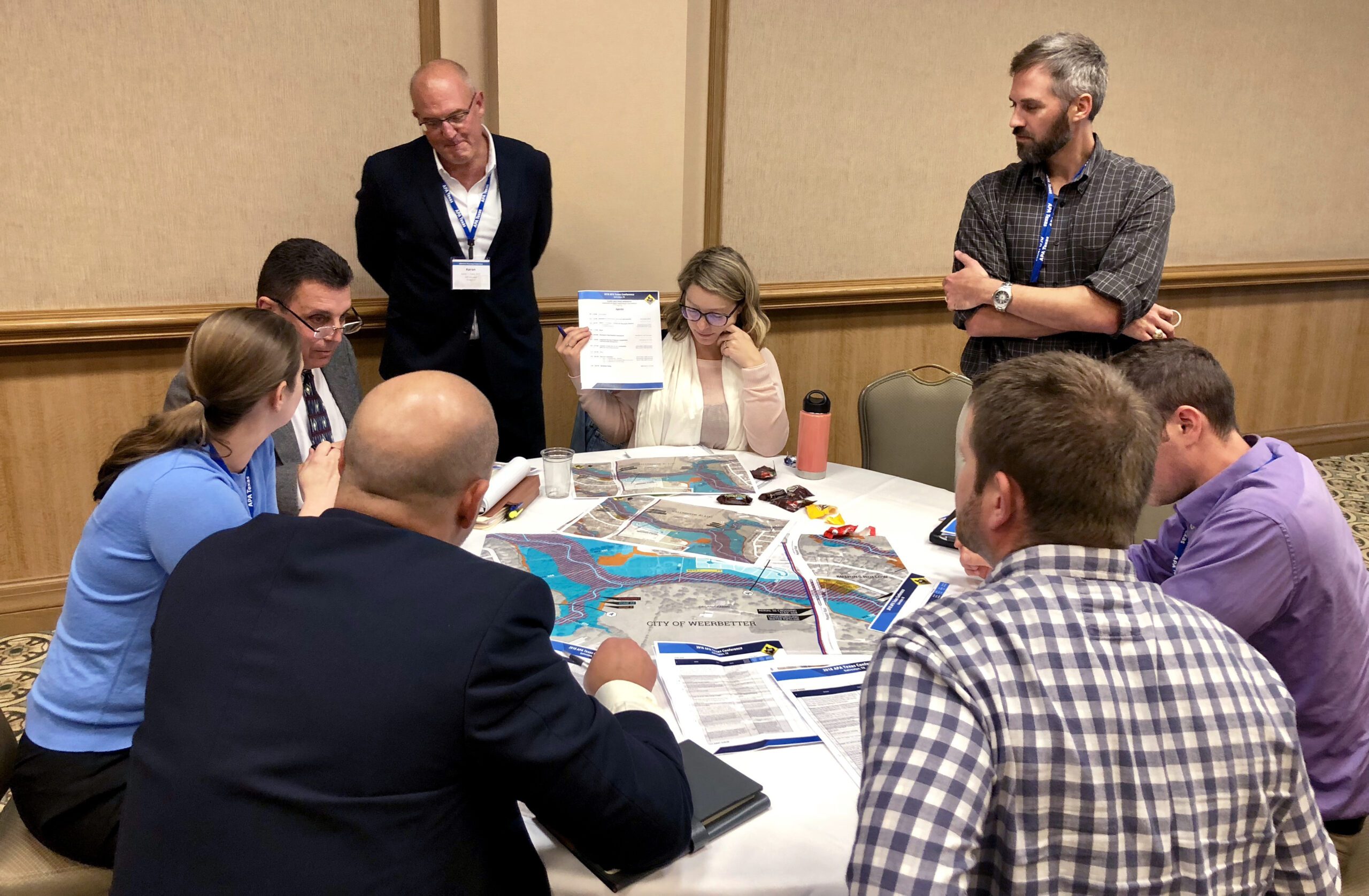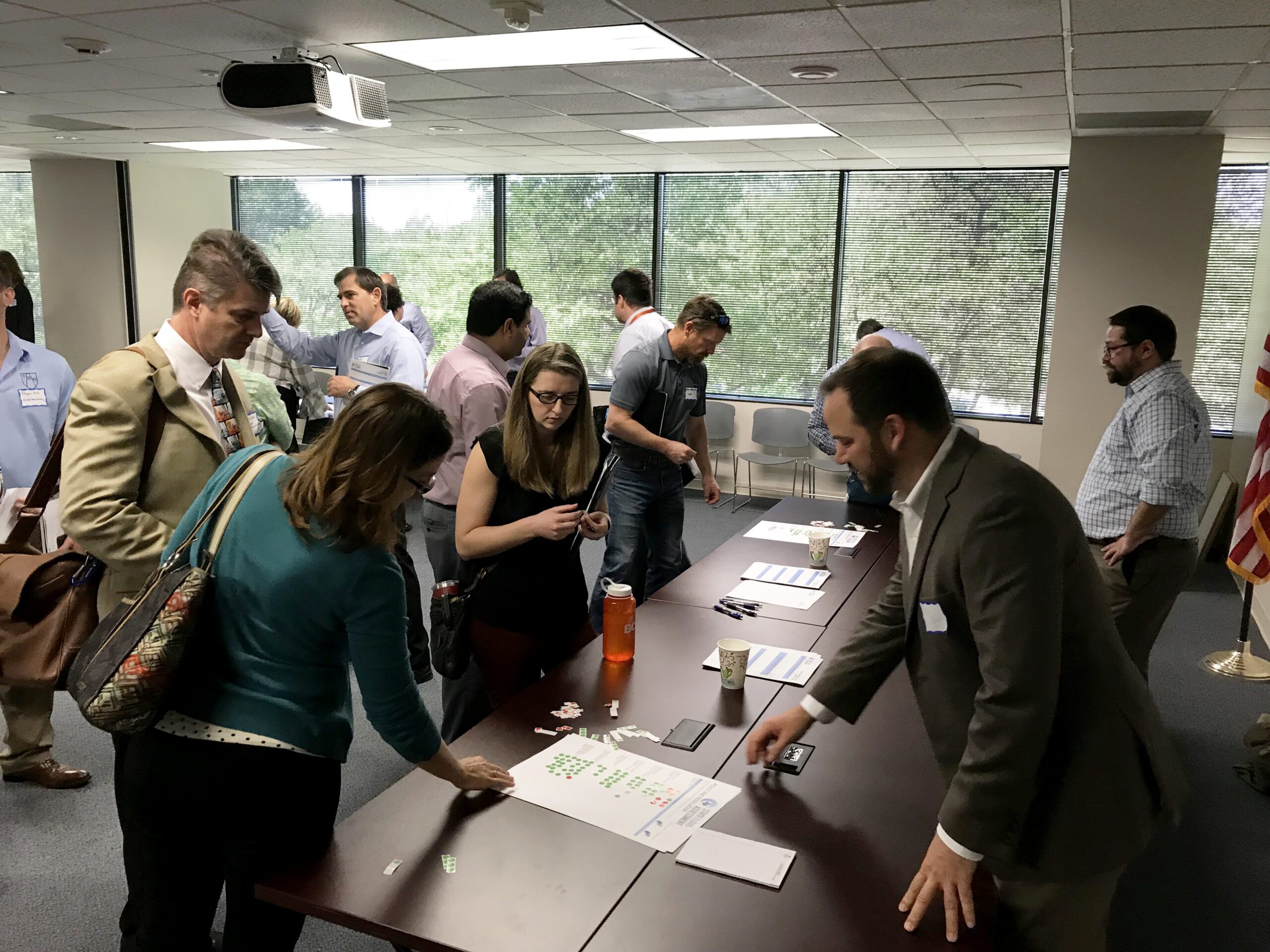Roundtable: Why a Collaborative Approach to Flood Resilience Is Important
The 2018 APA Texas Conference last fall included a workshop titled, “Flood Safe Texas—Collaborative and Modern Approaches.”
The key word in that title is collaborative.
Collaboration certainly is not a new concept, but it can be challenging when planners, floodplain managers, public works professionals and elected officials each own responsibility to prepare their communities to be more resilient in the face of flood risk.
There are many obstacles that come into play, and sometimes opportunities to collaborate for the greater good aren’t easily recognized by all parties.
Regional experts Edith Marvin, PE, and Tamara Cook, AICP, ISSP-SA, LEED Green Associate, from the North Central Texas Council of Governments’ Environment and Development department recently joined Halff Vice President Jessica Baker, PE, CFM, PMP, and Halff Director of Planning Matt Bucchin, AICP, LEED Green Associate, for a roundtable conversation about collaboration.
Edith, who has more than 25 years of engineering experience, directs the Environment and Development department. Tamara is a senior program manager who has worked at NCTCOG for 15 years. Meanwhile, Jessica is a past president for the Texas Floodplain Management Association (TFMA). Matt chairs the American Planning Association’s Sustainable Communities Division.
Before we examine the hurdles that prevent collaboration from occurring, why is collaboration so important for flood risk, and what are the benefits?
Edith: “You have to agree upon what methods you’re going to implement in your community, and that goes all the way up to collaboration with your elected officials. If they are not on board, you can’t just tell the public you have listed out your new regulations. You’re just going to have a mess to clean up. Even from a message and regulation standpoint, you have to collaborate ahead of time so you all have a path to follow. And it is important because otherwise the public wants to know (when something happens), ‘Why didn’t you all talk about this years ago? Why did you let this happen to me?’ ”
Tamara: “In terms of flood risk and resilience, at the heart of that in any collaboration should be what’s best for the community and the residents who live there.”
Jessica: “Watersheds aren’t based on political boundaries. I feel like the nature of our industry and the way water flows almost require collaboration. You need to have that watershed group who are all on the same page because what one does is going to affect upstream and/or downstream. It’s essential for safety.”
Edith: “And there aren’t unlimited resources, so you have to do the best you can with what you have to protect your public. One community may not have many resources at all, but they still need to be thinking about it and have some sort of plan.”
Jessica: “To me, that limited resource issue is the No. 1 reason for collaborative approaches because we can do more together.”
Tamara: “The leveraging of resources is a big one. When you collaborate, you find a lot of opportunities that you would not have found otherwise.”
Matt: “I agree. I think collaboration between planners and our technical experts is critical to achieving successful outcomes. Reducing flood risk in a manner that is both effective and cost efficient, and building a resilient community—these are such complex issues. They require a clear and consolidated vision at the beginning, an informed understanding of implementation and community buy-in at every stage of development.”
Flood Safe Texas workshop participants analyze a scenario presented to the group.
What are some of the obstacles you encounter when it comes to collaboration for flood risk?
Edith: “When you’re working for a local government, in particular, having your area of responsibility defined is very important in order not to step on each other’s toes—just because you’re all working with the same tax dollars, in theory, toward the same goal. So it’s important to define your area of responsibility, and that can actually be an obstacle to collaboration because you’re trying to stay in your lane. Unless you feel like you have that encouragement from others sitting at the table with you, you may be hesitant to get outside of your area of responsibility.
“Another thought I had was simply on other priorities. An obstacle to collaboration can be that you’re too busy with your other priorities and responsibilities to stop and focus on something.
“Also, different personalities can be an obstacle. Take the same profession, take different professions, and put folks in the same room. You may have as many different opinions about something as you have people. That makes collaboration difficult, but that’s part of the reason why it’s so effective.”
Tamara: “I have found that if you don’t have a champion—even if everyone is on board with collaborating—it’s never going to be successful. You have to have that one entity or one person or group of people who will step up and lead. Sometimes it takes a lot of convincing to make a person understand they are the right person to lead.”
Jessica: “I thought Edith’s comment about staying in your lane was interesting. When you mention a local community, they have their tax dollars at work, so you often think about, ‘How can I streamline processes or make projects go more efficiently and quicker?’ Putting two people on an issue could be seen as a duplication of effort versus the benefit of gaining multiple perspectives. Is it an obstacle that you are spending more resources and more effort by collaborating?”

Matt: “The very framework of how local government typically operates makes true collaboration difficult. Yes, all departments and staff are working from the same tax dollars and toward improving their community, but the process makes progress through some very defined mechanisms, annual budget requests and operations, capital improvements and new infrastructure, new plans and studies—most of which are initiated and managed in a department’s individual lane or area of specialty. It takes a concerted effort at the onset—a new approach—to bring all disciplines together to attack a high priority, interdisciplinary issue like reducing flood risk.”
Tamara: “An obstacle to collaboration, I think, is when someone or a group of people feels so overwhelmed by the thought of trying to collaborate on a topic like flood resilience because it’s such a big topic, and you just give up. If you break it down into chunks of achievable measures or problems and focus on one thing together, you will make progress.”
Edith: “Economic disadvantage or competition is another. A lot of times when there is a concept that is not tried and true practice everywhere—our communities will ask the question right off the bat: ‘How many other communities are doing this?’ If you’re not satisfied with that answer, then collaboration is not going to happen because you will already have decided.”
A shared understanding of flood risk problems is an important piece to the puzzle in any community.
Is it difficult to recognize ways to collaborate? Why would we fail?
Tamara: “I’ll just put it in the context of the workshop we held. That was the reason why we wanted to bring the material and specific presenters and topics to the group of people that we did. We knew they weren’t aware of those items they needed. There’s a disconnect somewhere, whether it’s cross-training … I guess it goes back to everybody is trying to stay in their lane but needing cross-training in other areas that actually do impact them. They just don’t always recognize that. The workshop actually demonstrated that to me.”
Edith: “One of the things that made the collaboration so easy (at the workshop) was that the problems were identified. If you think about a hazard mitigation plan, that’s what it’s all about—identifying your problems and documenting them so you know what you need to work on. A sustainability plan is very similar. All of this resilience and flood prevention ties together, and the easiest way to come to a collaboration point is by knowing what your problems are. If you don’t have problems written down, it’s hard to recognize an opportunity.”
Jessica: “Having a shared understanding of the problems is important as well. A city’s needs may intersect such as road improvements and storm drainage upgrades. You have to look for ways to use funds most effectively.”
Matt: “The Flood Safe Texas workshop, and several other sessions at the conference, highlighted that planners needed—almost craved—more background knowledge on the ‘technical’ issues related to understanding and reducing flood risk and building community resilience. Planners, by their training and the nature of their daily job activities, are uniquely positioned to break down the silos and increase collaboration. Sometimes, however, it is difficult to overcome standardized processes and the easiness of, ‘This is the way we have always done it.’ ”
The Flood Safe Texas workshop taught the importance of planners, engineers and elected officials working together to solve issues.
What best practices or outcomes from the workshop can be shared?
Edith: “Some people have strengths in engineering, and some have strengths in planning. You need both. You need the thinker ahead of time, saying, ‘What are we going to do about this? What if this happens?’ And then you need the solution people who say, ‘I have an idea. What if we did this?’ ”
Tamara: “Tools and technology have advanced. There are better decision-making resources at our fingertips now that make these decisions and conversations easier. You can put a map up, and everyone can understand what a watershed is. There are several different elements to why collaboration maybe seems newer.”
Jessica: “Set what success looks like. Set some game rules or parameters, especially if you’re all playing from different playbooks in different cities. Here are the ground rules for this, and how we’re going to collaborate to succeed and reach our common goal.”
Matt: “Solving certain issues, such as reducing flood risk, requires cities to re-evaluate how they approach growth. Success, moving forward, will require some non-traditional, out-of-the-box solutions. Planners need to take a leadership role in initiating these discussions and bringing the right people to the table.”
Write to HalffResilience@Halff.com for more information. Contact Edith Marvin at emarvin@nctcog or Tamara Cook at tcook@nctcog.






